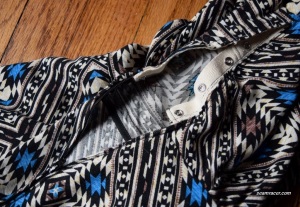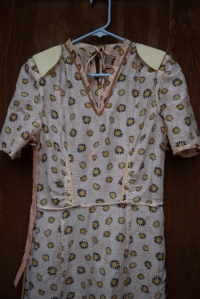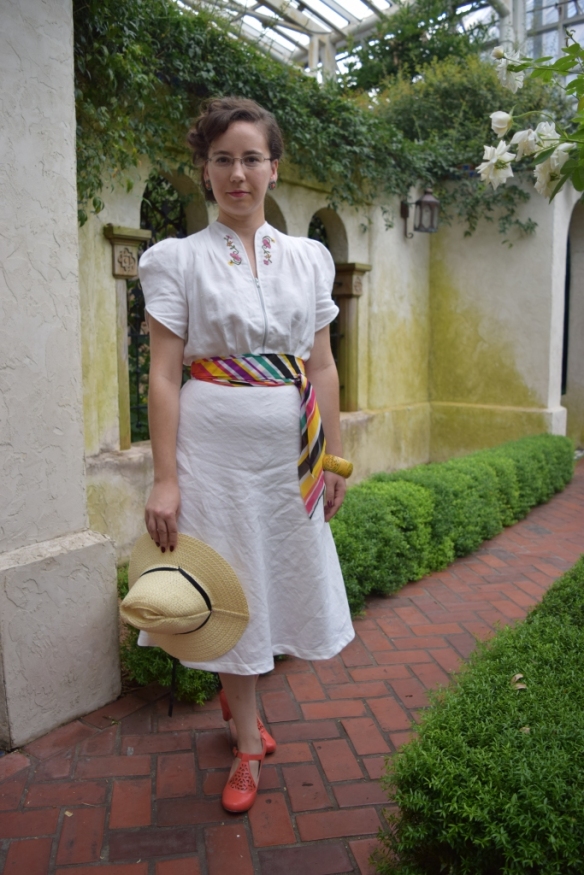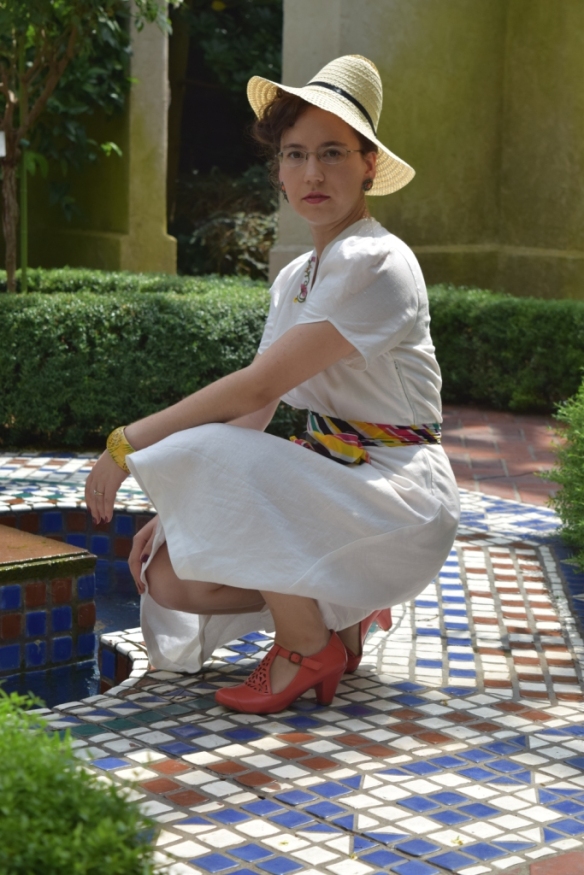Vintage multi-piece play suits have always intrigued me with their lovely mix-and-match factor and smart wear-ability. Thus I had to make my own rather than just keeping up the looking and admiring!

When I say ‘play suit’, I am not talking about the modern interpretation of the term as a sort of jumpsuit. I mean the 1930’s to pre-1960’s outfits geared for play, sport, leisure, and/or swim time which are often comprised of several pieces layered for practicality – a more skin revealing under set complete with add-on pieces for more decency when going out, as well. (See this blog post on the “Vintage Dancer” for more info and pictures on 1940’s play suits.) Here, my play suit is a four piece set of a self-drafted sarong skirt, a tie-front crop top, and a pair of skirt-like shorts (skort), all true to the 1940’s, while part four is a knit ¾ sleeve shirt for a modern touch. 
These pieces were made a while back as my submission for the “Vintage Play suit Sew Along” in May 2014 sponsored by “Girl with the Star Spangled Heart”. The skirt is what sees the most wearing, with the sports skirt/shorts and the knit shirt both coming in second. As our land-locked mid-west of America is woefully lacking in bodies of water, the crop tie top is the least worn (not what I would wish). Pool side lounging here I come!
The location for our photo shoot is again our town’s lovely 1930’s wonder in architecture, the Chase Park Plaza. Our last photos taken at this location, albeit inside, were for the blog post about my emerald green 1930’s Vionnet evening gown. This time we took advantage of their lovely pool courtyard and a slow, unpopulated lounge area to have a period background…complete with palm trees to match my fabric!

THE FACTS:
FABRIC: All of the 1940’s pieces (the skirt, the tied crop top, and the skirt-like shorts) are all in 100% rayon challis. The ¾ sleeve modern top is made of 100% cotton interlock knit. All fabrics were bought at the now defunct Hancock Fabrics.
 PATTERNS: A vintage Simplicity 3356, from the year 1940, was used for the skirted shorts; a vintage Hollywood 1479, from the year 1944, was used for the crop tie top; a year 2006 Simplicity 4076 was used for the knit shirt; and the long sarong skirt was self-drafted by me…so no pattern here! By the way I definitely have plans to make the jumper ad blouse from Simplicity 3356, as well as the nightgown from Hollywood 1479!
PATTERNS: A vintage Simplicity 3356, from the year 1940, was used for the skirted shorts; a vintage Hollywood 1479, from the year 1944, was used for the crop tie top; a year 2006 Simplicity 4076 was used for the knit shirt; and the long sarong skirt was self-drafted by me…so no pattern here! By the way I definitely have plans to make the jumper ad blouse from Simplicity 3356, as well as the nightgown from Hollywood 1479!
 NOTIONS: Just the normal notions were needed and were on hand – thread, interfacing, bias tape, and buttons (which were from hubby’s Grandmother’s stash). The only thing I had to buy was a duo of zippers.
NOTIONS: Just the normal notions were needed and were on hand – thread, interfacing, bias tape, and buttons (which were from hubby’s Grandmother’s stash). The only thing I had to buy was a duo of zippers.
TIME TO COMPLETE: Making a play suit is a bit of a time investment, but the two tops and the skirt were easy and quick, taking only about 3 or 4 hours each. The skirted shorts took longer, at about 20 hours. The tie-front crop top was done on May 23 while the sarong skirt was finished on June 2, and the skort on June 12, all in the year 2014. The ¾ sleeve knit top was made in 2006 or 2007.
THE INSIDES: Well, the older knit top was made at my parents’ house so I took advantage of their serger (overlocker) for the seams. Otherwise the rest of the seams on the rest of the garments for the play suit set are in mostly French seams with some bias bound seams, too.
I know, I know – my tie-front crop top actually comes from a pattern for nightwear – how risqué! It is pretty much similar to other play suit and bra top patterns from the 1940’s. I love how it shows just enough skin while still keeping me covered (it still has puff topped sleeves, after all). I can wear normal underwear or a swimsuit top under this easily, which is nice that it does not require anything different. Actually, I anchor the tie front of the top to the center front of my bra…oops, too much info. Best of all, it was super easy to whip up. This is the main reason I took the extra time to do the tiny hem and the French seams.

The sarong style wrap-skirt was very fun to make and I am happy that I was able to re-create what I envisioned, something not always achieved. Sorry if I get a bit technical here but simple complexity is hard. You see, when I think of sarong, I picture a skirt that is in 3D, meaning I see it as supposed to have flowing movement yet clinging drape. All the reprints and reissues I see available did not fit the bill – they are all either merely side tie skirts with some sort of gathers or tucks to create drape and a simple back view but basically just plain skirts, still not the ultimate hottie level. At first planning, I will confess, I was going to use something simple from on hand such as McCall’s 6519, from 2012, or a McCall’s 5430, from 2007, but after making the crop top I was left with only 1 ½ yards making all my chosen patterns no longer feasible, so I went for the self-draping route. Since I do not have a mannequin I had to stand in front of our full length mirror with my pin box nearby and experiment with different tuck and dart placement and direction. I did not cut into the fabric at all, merely stitched and manipulated one yard and a half cut (60 inches wide) into what you see.
 I will lay out my method of drafting the skirt as best I can so hopefully you can do the same if you’d like too! First I chose which length would be the circumference of my waist and hemmed that edge. Next, I found the center of that waist edge and figured that would be the back, then measured several inches out from that point to make some small (maybe ½ inch) darts for about 8 or less inches down. Now the back of the skirt is done. Next, I put the back up against myself and marked with pins what would be the side seam points on each side. Then I started the experimental parts where adding a few small angled tucks to each side seam was successfully tested. My tucks are angled opening up towards the back of the skirt – this brings in the skirt to gently shape under the booty and around and over the hips for an hourglass outline. This step was hard to do. I actually had to pin the waist
I will lay out my method of drafting the skirt as best I can so hopefully you can do the same if you’d like too! First I chose which length would be the circumference of my waist and hemmed that edge. Next, I found the center of that waist edge and figured that would be the back, then measured several inches out from that point to make some small (maybe ½ inch) darts for about 8 or less inches down. Now the back of the skirt is done. Next, I put the back up against myself and marked with pins what would be the side seam points on each side. Then I started the experimental parts where adding a few small angled tucks to each side seam was successfully tested. My tucks are angled opening up towards the back of the skirt – this brings in the skirt to gently shape under the booty and around and over the hips for an hourglass outline. This step was hard to do. I actually had to pin the waist back to the top I was wearing that day so I could experiment with the darts. After the waist sides were o.k. and top-stitched down, I worked on adding deeper tucks to the ends of the wrap. These tucks are also sloping, between horizontal and vertical, and there are more on the end that is seen from the outside than on the end inside. The front corners were softened to a rounded drape by merely turning in the bottom hem front points at an angle and simply taking them down. To close the wrap inside is an elastic strap with a waistband hook (to make things semi forgiving), and on the outside a lovely olive green shell button with another loop of elastic. Totally ready to be whipped on…or off if I need to just wear the skirted shorts underneath.
back to the top I was wearing that day so I could experiment with the darts. After the waist sides were o.k. and top-stitched down, I worked on adding deeper tucks to the ends of the wrap. These tucks are also sloping, between horizontal and vertical, and there are more on the end that is seen from the outside than on the end inside. The front corners were softened to a rounded drape by merely turning in the bottom hem front points at an angle and simply taking them down. To close the wrap inside is an elastic strap with a waistband hook (to make things semi forgiving), and on the outside a lovely olive green shell button with another loop of elastic. Totally ready to be whipped on…or off if I need to just wear the skirted shorts underneath.

I’ve worn my skirted shorts with my vintage blouses, and this gives me a very 30’s looking sports outfit. I can wear them with modern tops and it looks fun and flirty, especially with some flat sandals. Tops from other decades, with some large victory rolls or a ponytail, give a vintage-does-modern appeal. The way I can change up the aura of the date of these skirt-like shorts is the best perk. These shorts do have such a wide hem they are not the best for some exercising (too revealing) but are awesome for playing tennis in, I tried that out!

As great as these vintage skorts are, I do need to try again in the future to make a better version. The main problem with this pair is I believe the rayon challis fabric I chose. It’s so wrinkly for something with details that you only sit on to mess up any ironing work, it doesn’t hold up well the minute I start to sweat – the fabric not tight enough. With the rayon, I end up with darker colored spots where it’s wet from sweat (…embarrassing) and I’m beginning to get obvious holes from tension at the spots where the pleat top-stitching ends. Rayon on top of rayon is also rather too stifling to wear for the summer. Perhaps next try, I’ll sew these up in a cotton blend gabardine. Reconstructing History has some 1944 play shorts that are very similar to the one’s I made and they recommend rayon, linen, cotton (all too light and wrinkly) as well as denim. Any other suggestions for another fabric thick enough, low on the wrinkle factor, and good for summer comfort all combined for my next play suit shorts?

I kind of fudged my way through these vintage shorts as best I could but it was a real struggle. What took the most time to make the skorts was due to the fact that the pattern was unprinted. I’ve worked with unprinted patterns many times before, but with all the pleats, together with the grain line markings and such, my limits of comprehension of connecting the right dots was put to the ultimate test. To top it off, in order to support the skorts’ pleats across the belly and cut down on any see-through issues, I had to draft my own one piece liner to go inside. The liner was a great idea and really needed, but a second layer of rayon, on top of rayon, was not the best idea…should have used something else  which was lighter like batiste perhaps. The instructions gave no clear designation of what to do with the space under the side button closures – I had ideas of adding in pockets, or full button closure (sailor-style), but finally settled on the easy-but-not-so-authentic option of zippers. Looking back, I really don’t need double closures (there are buttons and zippers on each side seam), and next time I will eliminate one side to sew it closed and add in a button or hook-and-eye method like I’d thought. Darts were even added to the inside of the waistband to give it more curve and bring it in – I believe it was drafted too straight. I’m tired just going through its problems. Oh well, I like what I have and now I know what to do and what to change for the next attempt at this lovely, complex design.
which was lighter like batiste perhaps. The instructions gave no clear designation of what to do with the space under the side button closures – I had ideas of adding in pockets, or full button closure (sailor-style), but finally settled on the easy-but-not-so-authentic option of zippers. Looking back, I really don’t need double closures (there are buttons and zippers on each side seam), and next time I will eliminate one side to sew it closed and add in a button or hook-and-eye method like I’d thought. Darts were even added to the inside of the waistband to give it more curve and bring it in – I believe it was drafted too straight. I’m tired just going through its problems. Oh well, I like what I have and now I know what to do and what to change for the next attempt at this lovely, complex design.
 Last but not least is my modern ¾ sleeve knit top, which was picked out of my closet during the planning stage of my playsuit as something which was finally going to have a specific outfit to match with. I had made it such a while back and it never has seen that much wearing previously because it’s gentle dusty green never match with much but a solid skirt or denim. Not that this is the only modern top I wear with the play suit, but it gives me a reason to highlight what I remember as my first totally successful me-made top. It really has some body hugging shaping if you make your “correct-according-to-the-chart” size. If you don’t want it to fit you as snugly, go up a size. Also, I found the length to be a bad spot – too short to tuck in and not long enough for it not to ride up untucked – so making the hem longer might be a good idea. Otherwise, this is a great top and easy to make and wear. I’ll have to go back to the pattern and make some of the other views offered!
Last but not least is my modern ¾ sleeve knit top, which was picked out of my closet during the planning stage of my playsuit as something which was finally going to have a specific outfit to match with. I had made it such a while back and it never has seen that much wearing previously because it’s gentle dusty green never match with much but a solid skirt or denim. Not that this is the only modern top I wear with the play suit, but it gives me a reason to highlight what I remember as my first totally successful me-made top. It really has some body hugging shaping if you make your “correct-according-to-the-chart” size. If you don’t want it to fit you as snugly, go up a size. Also, I found the length to be a bad spot – too short to tuck in and not long enough for it not to ride up untucked – so making the hem longer might be a good idea. Otherwise, this is a great top and easy to make and wear. I’ll have to go back to the pattern and make some of the other views offered!
Gertie’s summer 2016 release of Butterick 6354  gave me quite a surprise at how similar it is to my own play suit – especially in the choice of fabric pattern and colors – as I mentioned before in this post. These colors and this “palm leaf with flowers” seems to be rather prevalent when I was looking at play suit inspiration – see this color picture of actress Peggy Moran at “Glamourdaze”, or visit my Pinterest board for more. I do find Gertie’s play suit as sort of a hybrid blend of pieces that make it more of something from the 50’s era, though it does seem awkwardly like it sort of should be from the 40’s. Besides, one could make this set from patterns already released (such as Simplicity 8130 for the tops, Vintage Vogue 9189 for the shorts, out-of-print Vintage Vogue 8812, year 1940, for the bolero, and any adapted pencil skirt or real wrap skirt pattern for the mock-wrap skirt). Sorry…I’m not meaning to criticize, I just would rather see variety than redundancy in the patterns that are released.
gave me quite a surprise at how similar it is to my own play suit – especially in the choice of fabric pattern and colors – as I mentioned before in this post. These colors and this “palm leaf with flowers” seems to be rather prevalent when I was looking at play suit inspiration – see this color picture of actress Peggy Moran at “Glamourdaze”, or visit my Pinterest board for more. I do find Gertie’s play suit as sort of a hybrid blend of pieces that make it more of something from the 50’s era, though it does seem awkwardly like it sort of should be from the 40’s. Besides, one could make this set from patterns already released (such as Simplicity 8130 for the tops, Vintage Vogue 9189 for the shorts, out-of-print Vintage Vogue 8812, year 1940, for the bolero, and any adapted pencil skirt or real wrap skirt pattern for the mock-wrap skirt). Sorry…I’m not meaning to criticize, I just would rather see variety than redundancy in the patterns that are released.
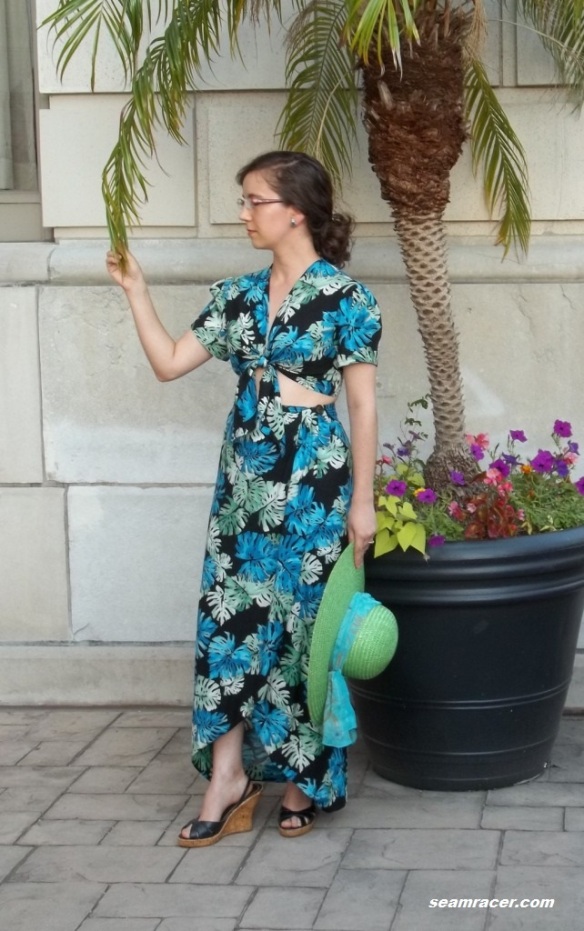
As I mentioned above, play sets are a bit labor intensive, after all you have to make three or four separate garments just for a finished set! However, it’s well worth it, especially when done with a vintage perspective for those of us who love the styles from the past. Now I have some easy vintage garments that set my wardrobe up for some playtime, or easy dressing in style! Plus, it doesn’t hurt to feel a little of the past’s relaxed associated with holiday or hot-weather wear, does it?! This is much more fun than for me to wear than whatever most people wear for modern leisure/exercise time. Yet I’ll bet it’s more comfy…and less confining! I actually just finished sewing a year 1959 play set, so get ready for an upcoming post on my interpretation of vintage sporty wear courtesy of the next decade! Now if only summer would last a bit longer…
Save
 TIME TO COMPLETE: This was whipped up in about 3 or 4 hours and finished on May 10, 2016
TIME TO COMPLETE: This was whipped up in about 3 or 4 hours and finished on May 10, 2016 force, with many of those enlisting seeing a big city for the very first time and many being in their early teens posing as older young men. About 400 Navajos were chosen for a special WWII code unit (in 1942) to develop secret messaging for use on the Pacific front, offering the U.S. a code which could not be broken. On a more personal level, 1938 was also the beginning of the first established high schools and centers for education on reservations, to bring more progressive and wide spread learning sponsored by the BIA (Bureau of Indian Affairs). Previously, the “Indian New Deal” of the Depression played down schools and learning for this race. The Indian division of the CCC was building more community buildings, lands were being granted back in 1938 and ’37, natural resources on their lands were protected by the “Mining Act”, and Anglo writers were transcribing oral tradition into written form. No group that participated in World War II made a greater per capita contribution than Native Americans, and between this fact and changing attitudes, the time period before and after 1938 was one of significance for these people. I would like to recognize this and let my dress do the extra showing of respect.
force, with many of those enlisting seeing a big city for the very first time and many being in their early teens posing as older young men. About 400 Navajos were chosen for a special WWII code unit (in 1942) to develop secret messaging for use on the Pacific front, offering the U.S. a code which could not be broken. On a more personal level, 1938 was also the beginning of the first established high schools and centers for education on reservations, to bring more progressive and wide spread learning sponsored by the BIA (Bureau of Indian Affairs). Previously, the “Indian New Deal” of the Depression played down schools and learning for this race. The Indian division of the CCC was building more community buildings, lands were being granted back in 1938 and ’37, natural resources on their lands were protected by the “Mining Act”, and Anglo writers were transcribing oral tradition into written form. No group that participated in World War II made a greater per capita contribution than Native Americans, and between this fact and changing attitudes, the time period before and after 1938 was one of significance for these people. I would like to recognize this and let my dress do the extra showing of respect.